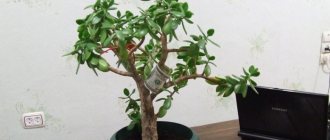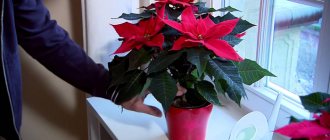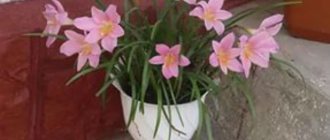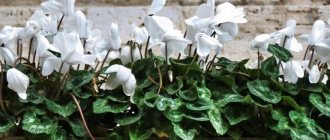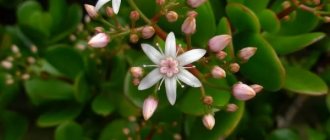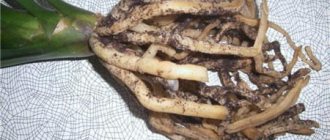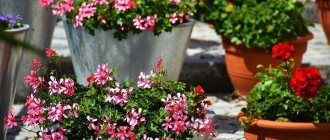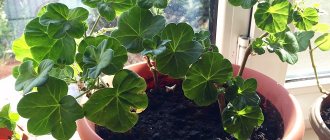The beautiful Euphorbia (Euphorbia pulcherrima), also called poinsettia (Poinsettia), is a representative of the Euphorbia genus of the Euphorbiaceae family. In the wild, such a plant can be found in the tropical regions of Central America and Mexico. This plant is an evergreen shrub because in its wild habitats it reaches a height of up to 4 meters. However, when grown at home, the height of the bush reaches only 0.3-0.5 meters. The dark green, ellipsoid-shaped leaf blades have petioles, a serrated edge and are 10 to 15 centimeters long. The rosette-shaped inflorescences consist of pale yellow small flowers, and around them deep red bracts are formed, while unknowing people believe that these are flowers. Today, thanks to breeders, varieties with white, pink, yellow bracts, as well as bicolor ones, have appeared. This plant was named after the first American Minister of Mexico, Joel Roberts Poinsett, who was fond of botany and admired the beauty of poinsettia. This plant blooms at Christmas, which is why it is also called the “Christmas star” or “Star of Bethlehem”.
What does it take to achieve flowering?
If you grow poinsettia at home and do not follow the nuances of caring for the plant, you may not wait for the poinsettia to bloom. There is a whole instruction, the exact implementation of which leads to the fact that the most beautiful milkweed will definitely bloom on the eve of the New Year holidays.
How to “light” a Christmas star on a windowsill?
In its natural environment, poinsettia blooms in conditions of short daylight and long night. How to make a plant bloom at home? It is necessary to artificially create a lighting regime similar to natural.
Start limiting daylight hours from the end of September. From six to seven o'clock in the evening, put the poinsettia in a closet or cover it with a dark box that does not let in light. It is necessary to hide the plant from light until seven to eight o'clock in the morning. Poinsettias should be kept in the dark for about 14 hours a day.
During the day, place the plant in the brightest place. Water and spray as usual. Fertilize regularly. Keep the poinsettia in such conditions for eight to ten weeks.
Important! The darkening must be absolute, otherwise the bracts will be unevenly colored.
As soon as flower buds appear and signs of coloring of the bracts are noticeable, stop darkening. Stop feeding. If these conditions are met, the poinsettia will definitely bloom by Christmas. To increase flowering time, keep the temperature slightly lower than normal.
Poinsettia propagation
The flower called "Christmas Star" is propagated by cuttings in spring or early summer. To do this, take the tops of the shoots with 5-6 internodes.
All sections must first be dried and then sprinkled with charcoal powder. Then put them in warm water so that the juice flows out, and then treat the cut with Kornevin. Next, put them in water or plant them in a substrate moistened with water with a growth stimulator.
To propagate poinsettia, it is better to plant several seedlings. You can cover them with a cut plastic bottle. You just need to make sure that the air in the greenhouse does not exceed 28 degrees (it’s better if it’s 18-21 degrees).
Plants need to be ventilated and sprayed daily. After 30 days, roots should appear and new flowers can be planted in separate pots and maintained as usual.
Autumn cultivation is no different from summer, only in the fall the grown bushes should be planted in larger containers. If you propagate the beauty in this way, it will bloom only next year.
The process of bud formation
The regime of artificially created short daylight hours leads to the formation of flower buds on the plant. Poinsettia flowers are small and inconspicuous and can be pink, yellow-green or white. After the formation of flower buds, in late November - early December, the coloring of the bracts begins.
This is the name given to the leaves located around the inflorescence. They are assembled into a rosette shaped like a star. It is the bracts that create the spectacular appearance of poinsettias during the flowering period.
The leaves can be bright red, white-pink, lilac, cream or white. The plant appears in all its glory by the end of December. Hence another name for poinsettia - Christmas star. The color of the bracts lasts up to six months.
Recommendations for those who want to buy poinsettia
The flower is very similar to the Christmas star. At home, it grows up to 3 meters, and the hybrid reaches a height of only 30 centimeters. Today, a low plant can be grown at home, decorating the interior.
It spread around the world after Joel Poinsett, the Minister of Mexico and a lover of botany, working on improving this flower, received a wonderful hybrid.
The colorful plant has another name - spurge. The next name - “Bethlehem star” or “Christmas star” - was given to the flower by florist Albert Ecky. The flower blooms just in time for Christmas, dispelling the winter blues with its scarlet colors.
Seeing this miracle of nature, American residents began to decorate their homes with it just in time for Christmas. Then this plant began to spread throughout the world. The unique appearance of poinsettias is given by bright, red, yellow, white or pink bracts, which are very similar to flowers.
When purchasing different plant varieties, you should pay attention to their characteristics. For example, poinsettia variety Cortez is a bush with white, yellow, and pink bracts. Sonora White has ivory colored perianths. Marbled spurge has bracts that resemble a marble pattern.
When buying a flower, give preference not to those brought from abroad, but to those grown in Russian greenhouses. Such flowers will take root better and will produce cuttings from which you can grow a healthy plant.
Pay attention to specimens where most of the flowers form buds, then they will bloom. Do not buy a plant with fallen buds or unhealthy foliage.
If it’s cold outside, then the Christmas star should be wrapped in thick paper and quickly taken home. After purchasing, the poinsettia does not need to be replanted immediately; it must adapt to new conditions.
Care during the rest period
Usually by the end of March the poinsettia has finished blooming, what should I do next?
- It is necessary to stop fertilizing and gradually reduce watering.
- When the bracts wither and the lower leaves begin to fall off, you should trim all the stems, shortening them to ten centimeters. Leave three to five healthy buds on each shoot, which will provide new growth and become the basis for future flowering.
- Then the poinsettia is sent to rest. It is necessary to move the plant to a dry, shaded room, where it will be at a temperature of +14 to +16°C. Indicators should not fall below +10°C. The rest period lasts one and a half to two months.
- At this time, poinsettia practically does not need watering. In order not to completely dry out the soil, you should very rarely and carefully feed the plant with water through a tray. Don't forget to pour out excess moisture. Overmoistening of the substrate leads to rotting of the root system and above-ground parts of the poinsettia.
Which varieties to choose?
Poinsettias come in different varieties that differ in color.
Arctic White. Snow-white poinsettia looks very beautiful. Cool white flowers against the backdrop of rich green leaves will not leave anyone indifferent.
Premium Miro. The variegated pattern of its leaves looks original.
Mixed poinsettia looks even more original.
Lemon snow. The owner of a pale lemon color.
Orange Poincettias. The elongated leaves of this variety have a rich orange color.
Blue poinsettia. This view has mesmerizing beauty! The flowers are electric blue and are combined with rich green leaves, which are painted with uneven dark veins.
Strawberry and cream. The petals themselves are of a very unusual shape, reminiscent of a maple leaf. The color scheme is very delicate, the creamy pink color of the petal in the middle is washed out milky
Sonora Marble. A creamy beauty with an ivory hue interspersed with a pink tint in the middle.
Prestige Maroon. Queen among poinsettias! A rich, noble burgundy wine shade combined with dark emerald leaves gives this variety a regal appearance.
Caring for all types of plants is thorough and daily. They're worth it.
Why is the plant “capricious”?
Poinsettia is a rather capricious plant. She refuses to bloom for various reasons:
- lack of light and heat;
- dry indoor air;
- irregular watering;
- stress due to a change of place during the formation of buds;
- no pruning;
- inadequate feeding;
- pot size is too large;
- no rest period.
How to properly care?
Let's look at how to properly care for poinsettia so that it blooms. Optimal conditions should be created for the plant:
- Organize good lighting. In April - May, after a period of rest, place the poinsettia in the brightest place. Windows facing south and southeast are ideal for this.
- Maintain high air humidity - from 60 to 90%. Spray the area around the Christmas star with warm water from a spray bottle every day. Do not allow moisture to get on the leaves - they will become stained.
- Keep at average air temperature. Heat is contraindicated for the plant. The optimal temperature in summer should be from +20 to +25°C. In too cold a room, poinsettia stops growing and does not bloom. It is necessary to protect poinsettia from sudden temperature fluctuations, otherwise the plant will shed its leaves.
- Protect from drafts. Poinsettias lose their foliage even after short exposure to cold air.
- Water regularly twice a week as the top layer of soil dries. Use soft water that has been standing for several days. Make sure that moisture does not stagnate in the pan. In autumn, watering should be gradually reduced. In winter, carry out the procedure only once a month.
- Choose a pot that is not too large for your poinsettia. Otherwise, a lot of moisture accumulates in the container and the roots begin to rot. When initially planting, take a medium-sized pot. In the future, replace the tank with a larger one each time. The new pot should be two to three centimeters larger than the previous one.
- Keep poinsettia in loose soil that allows moisture and air to pass through. The optimal soil acidity is from 5.8 to 6.6 pH. A ready-made substrate is suitable for decorative foliage plants. You can form the soil yourself by mixing turf, leaf soil, peat and river sand in a ratio of 3:3:1:1. Before use, such soil must be sterilized with a weak solution of manganese.
In the spring-summer season, apply fertilizer every two weeks. In order for them to be well absorbed, it is better to alternate organic and mineral supplements. Strictly follow the concentration indicated on the package, otherwise you may harm the plant. Until the very moment of flowering, the most beautiful milkweed requires fertilizers with a high content of phosphorus and potassium.- A young plant should be replanted annually, and after reaching the age of three years - every two years.
- Do not replant poinsettias while they are in bloom. The procedure must be carried out after the end of the dormant period, when young leaves appear on the branches. The best time for transplantation is April and May. In this case, use the transshipment method - do not free the root system from the old substrate. This will protect the delicate roots of the poinsettia from damage.
- Give the plant a good rest every year after flowering has finished.
- Be sure to prune twice a year. The first procedure should be carried out after flowering - before the dormant period. The second - in April, after the transplant.
Pests
Nematodes
The action of scale insects is aimed at pumping juice out of indoor flowers. They gather in colonies in the veins and petioles of leaves, in thick, cotton-like secretions.
What to do: clean the plant with a swab soaked in soapy water, then spray with garlic infusion or calendula tincture. In difficult cases, apply insecticides Aktara and Fitoverm three times at weekly intervals.
Reference! Aktara and Fitoverm are systemic insecticides with enteric contact action. Active against nematodes.
Aphid
Aphids live on the most tender shoots of poinsettias, which are easier for them to pierce and become infected.
Help: wash the flower with soapy water. Next, you will need to treat with onion or tobacco infusion at intervals of 5 days. You can use the chemical Spark.
Reference! Spark is a contact-intestinal insecticide against sucking and gnawing insects. The active ingredient is avertin emulsion.
Spider mites
Spider mites are small red beetles that are difficult to see with the naked eye, but small yellowish spots near the tips of leaves indicate their presence. The spots are where the sap of the plant was sucked out. Spider mites are not very dangerous for a plant. To suck out all the juice, a poinsettia will require a huge number of mites, which is unlikely.
Reason: low indoor humidity.
Action: treat the surface of the leaves with insecticidal soap.
Mealybug
The mealybug is a sucking insect. The body is pink or white with transverse stripes on the back. Its appearance and size make it possible to see it with the naked eye. The insect produces white sticky mucus. The plant looks as if it has been sprinkled with flour or as if lumps of cotton wool have been placed on the shoots. The mealybug is hiding under these cotton balls. Leaves turn yellow when attacked by insects.
Reason: abuse of nitrogenous fertilizers, increased air temperature.
Help: treat with a damp sponge soaked in a garlic solution or a soap-alcohol solution (dissolve 1 tsp of grated laundry soap in hot water, bring the volume to 1 liter, add 1 tbsp. alcohol and 2 tbsp. vodka. Treat plant every 3-4 days).
By March 8, housewives are forcing tulips and hyacinths, and by Christmas they are growing poinsettias. This flower has always been a bright and colorful decoration for Christmas days.
Euphorbia sheds its lower leaves: what to do after this?
After flowering, the bracts turn green, then turn pale and fall off. The plant loses its decorative effect. The poinsettia then sheds its lower leaves, exposing the trunk. Some inexperienced gardeners decide that the plant is dead and get rid of it. In fact, poinsettias require pruning and rest before they will resume growth and be ready to bloom again.
We talked about what to do if the poinsettia gets sick and sheds its leaves in December, as well as about various diseases and pests of the plant in our material.
Poinsettia can be induced to bloom by creating a regime of short daylight and long night. With proper care, the Christmas star will delight you with its bright leaves on New Year's Eve, creating coziness and a festive atmosphere in the room.
Signs and superstitions
What does poinsettia bring to your home? The bright “Christmas Star” gives a good mood, joy, new ideas, a positive attitude, improves family relationships, and energizes. After purchasing or receiving the “Star of Bethlehem” as a gift, businessmen receive support in financial matters, and newlyweds receive joy and hope for offspring in the near future.
Many believe that the plant quickly senses the entry of negative energy into the house and begins to get sick. Perhaps one of your relatives or friends comes to your home with bad intentions?
Signs associated with plants often turn out to be quite accurate, but there are people who categorically reject such statements. Everyone decides for themselves whether to believe it or not, but looking at the blooming poinsettia and the riot of colors really improves your mood. The “Star of Bethlehem” is a bright ray of light in your home, a light that warms you in the middle of winter.
From the following video you can learn several tricks for luxurious and lush flowering of poinsettia:
